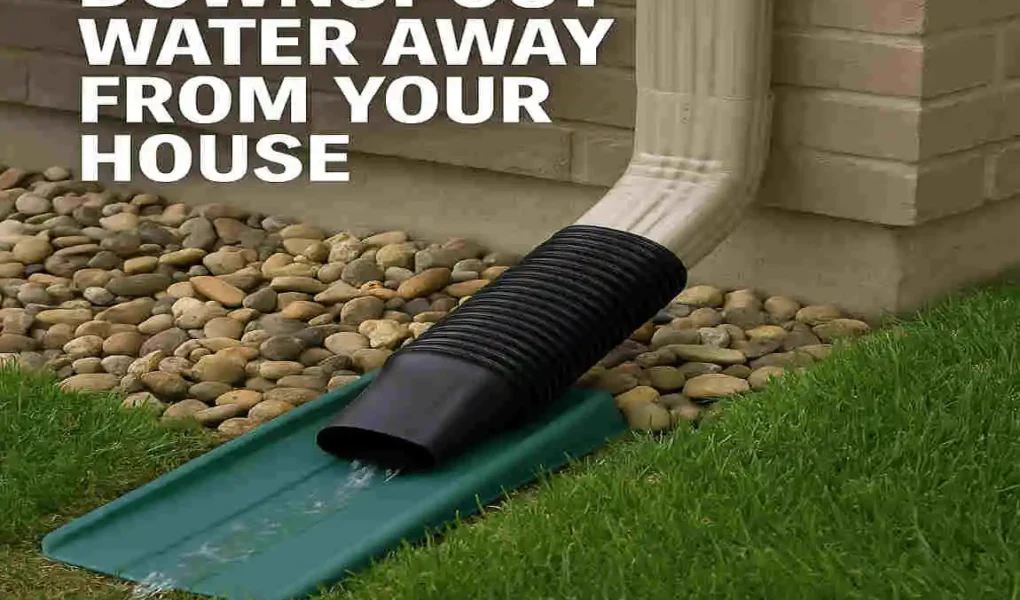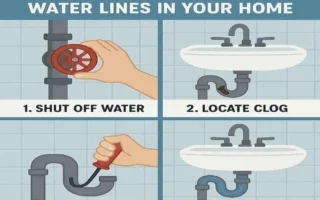Have you ever noticed water pooling around your home’s foundation after a heavy rain? If you’re nodding your head, you’re not alone. Managing downspout water drainage is one of those home maintenance tasks that often gets overlooked until it’s too late.
Here’s the thing – your downspouts play a crucial role in protecting your home from water damage. When they’re not working correctly, you’re looking at a whole host of problems. We’re talking about foundation cracks that can cost thousands to repair. Soil erosion ruins your carefully landscaped yard. And, worst of all, basement flooding can destroy your belongings and create dangerous mold.
The good news? Learning how to drain downspout water away from house foundations isn’t rocket science. With the proper knowledge and a bit of elbow grease, you can protect your home from water damage and save yourself from costly repairs down the road.
Understanding Downspouts and Their Role in Home Drainage

What Are Downspouts and Why Do They Matter?
Think of downspouts as the vertical highways for rainwater. These pipes, typically made of aluminum, vinyl, or copper, connect to your gutters and carry water from your roof down to ground level. But here’s where many homeowners miss the mark – getting water to the ground is only half the battle.
Your gutters collect rainwater from your roof and channel it toward the downspouts. Once the water enters these vertical pipes, it needs somewhere safe to go. Without proper drainage at the bottom, you’re essentially dumping gallons of water right next to your home’s foundation with every rainstorm.
The Science Behind Effective Drainage
Water follows the path of least resistance. When downspouts deposit water near your foundation, it doesn’t just disappear. Instead, it seeps into the soil, creating hydrostatic pressure against your basement walls. Over time, this pressure finds weak spots, leading to cracks, leaks, and structural damage.
A properly functioning drainage system works like a well-orchestrated symphony. Your gutters capture the water, downspouts transport it safely to ground level, and drainage extensions carry it away from your home. When any part of this system fails, you’re inviting trouble.
The Hidden Costs of Neglect
Ignoring your downspout drainage isn’t just about puddles in your yard. We’re talking about serious structural integrity issues. Foundation repairs can efficiently run into five figures. Waterproofing a basement after damage has occurred costs significantly more than preventing the problem in the first place.
Moreover, proper drainage protects your landscaping investments, prevents soil erosion, and maintains your property value. It’s one of those home maintenance tasks that pays for itself many times over.
Common Problems Caused by Poor Downspout Drainage

Foundation Damage: Your Home’s Worst Enemy
Let’s start with the big one – foundation damage. When water pools near your foundation, it doesn’t just sit there innocently. The soil around your foundation expands when wet and contracts when dry. This constant cycle creates movement that leads to cracks in your foundation walls.
Small hairline cracks seem harmless at first. But here’s what happens next: water seeps into these cracks. During winter, this water freezes and expands, widening the cracks. Before you know it, you’re dealing with significant structural damage that threatens your home’s stability.
Erosion and Landscaping Nightmares
Have you spent time and money creating beautiful flower beds around your home? Poor downspout drainage can wash away your hard work in a single storm season. The force of water coming from your downspouts creates channels in your soil, carrying away topsoil and exposing plant roots.
This erosion doesn’t just affect your plants. It creates uneven ground surfaces, damages lawn areas, and can even undermine walkways and patios. The result? Your once-beautiful yard becomes a muddy, uneven mess that requires extensive repair work.
Basement Flooding and Mold Growth
Nothing ruins your day quite like discovering water in your basement. When downspouts discharge too close to your home, that water has to go somewhere. Often, it finds its way through basement walls or floor cracks, creating puddles and moisture problems.
But standing water is just the beginning. High moisture levels create perfect conditions for mold growth. Within 24-48 hours of water exposure, mold can begin to form. This isn’t just a cosmetic issue – mold poses serious health risks, especially for those with allergies or respiratory conditions.
Structural and Aesthetic Consequences
Poor drainage affects more than just your foundation and basement. Water pooling near driveways can cause cracks and settlement. Sidewalks become uneven and dangerous. Your home’s siding can rot or develop mold stains. Even your home’s curb appeal takes a hit when visitors notice water damage and erosion.
How to Drain Downspout Water Away from House – Step-by-Step Guide
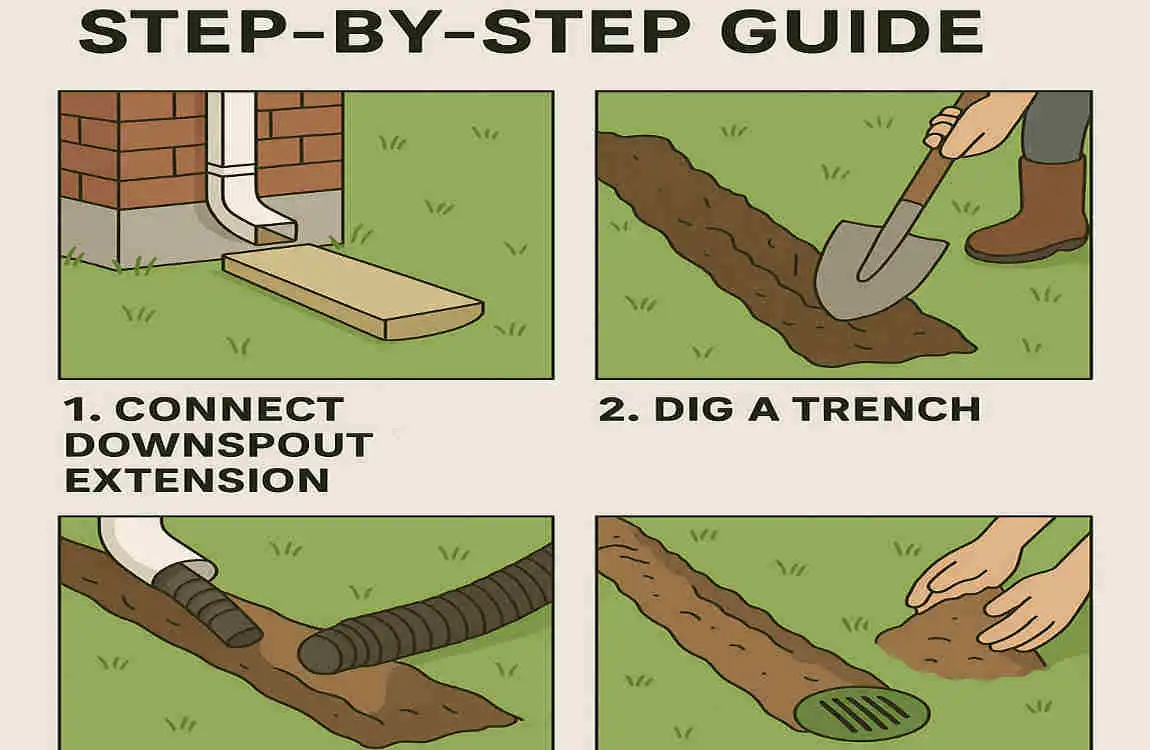
Inspect and Clean Your Downspouts and Gutters
Before you can fix your drainage issues, you need to start with the basics. Grab a ladder (and a friend for safety) and take a close look at your gutters and downspouts. You’re looking for leaves, twigs, and debris that might be blocking water flow.
Here’s a pro tip: use a garden hose to test water flow through your system. Start at the far end of your gutters and watch how water moves toward and through the downspouts. If you notice slow drainage or overflowing, you’ve found a clog that needs clearing.
Remove all debris using gloved hands or a gutter scoop. For stubborn clogs in downspouts, try using a plumber’s snake or a pressure washer. While you’re up there, check for leaks, rust spots, or loose connections. Minor problems now become big headaches later if left unaddressed.
Don’t forget to inspect the downspout outlets at ground level. Often, these areas accumulate leaves and dirt, creating blockages that prevent proper water flow.
Extend the Downspout Away from the Foundation
Now comes the crucial part—getting that water away from your house. The general rule? Water should discharge at least 4-6 feet from your foundation. Some experts recommend even greater distances in areas with heavy clay soil or a high water table.
You’ve got several options for extending your downspouts:
Flexible accordion-home style extensions offer an affordable, easy-to-install solution. They attach directly to your existing downspout and can extend up to 6 feet. The downside? They’re not the most attractive option and can be tripping hazards.
Rigid PVC pipes provide a more permanent solution. They look cleaner and can be buried underground for a seamless appearance. You’ll need to maintain a proper slope (at least 1/4 inch per foot) to ensure water flows away from your home.
Roll-out extensions automatically unroll when water flows through them and roll back up when dry. They’re convenient but may not work well in freezing pipe temperatures.
Create a Splash Block or Drainage Channel
Sometimes, simple solutions work best. Splash blocks – those concrete or plastic platforms placed under downspouts – help disperse water and prevent soil erosion. Position them so they slope away from your foundation, carrying water into your yard.
For a more robust solution, consider creating a drainage channel. Dig a shallow trench (about 6 inches deep) leading away from your downspout. Line it with landscape fabric, add a layer of gravel, and top with decorative stones. This creates an attractive French drain effect that manages water while enhancing your landscaping.
Another option? Create a rock bed or dry creek bed that serves both functional and aesthetic purposes. Use river rocks of varying sizes to create a natural-looking drainage path that guides water away from your home.
Install Underground Drainage Pipes

For the ultimate in water management, consider installing underground drainage pipes. This solution keeps your yard clean while effectively directing water away from your foundation. It’s more work up front, but it provides long-lasting protection.
Start by calling 811 to have utilities marked – you don’t want to hit a gas line or electrical cable. Then, dig a trench from your downspout to your discharge point. The trench should slope away from your house at about 1/8 to 1/4 inch per foot.
Use a solid PVC pipe near the house (first 10 feet) to prevent water from seeping into the soil near your foundation. After that, you can switch to a perforated pipe to allow gradual water dispersal. Connect your downspout to the house pipe using appropriate adapters and seal all connections.
At the discharge end, Install a pop-up emitter or daylight the pipe at a safe distance from your home. Some homeowners connect to existing storm drains (check local codes first) or create a dry well for water collection.
Use Rain Barrels or Water Collection Systems
Why waste all that rainwater when you can put it to good use? Rain barrels offer an eco-friendly solution that reduces runoff while providing free water for your garden. Modern rain barrels come in attractive designs that complement your home’s exterior.
Position your rain barrel on a stable, level platform directly under the downspout. Install plumbing a diverter kit that sends water to the barrel when it’s not full and bypasses it when it is. Make sure your barrel has an overflow outlet that directs excess water away from your foundation.
For larger properties, consider a cistern system capable of storing hundreds or thousands of gallons. These systems can integrate with irrigation systems, providing sustainable water management year-round.
Landscape Adjustments for Better Drainage
Sometimes, the best drainage solution involves reshaping your landscape. The ground around your home should slope away from the foundation at a rate of at least 6 inches over the first 10 feet. If your yard slopes toward your house, you’re fighting an uphill battle (literally).
Start by adding soil to create proper grading. Use clay-heavy soil near the foundation, as it’s less permeable than sandy soil. Compact the soil well to prevent settling. Then, cover with topsoil and seed or sod to prevent erosion.
Consider installing a swale—a shallow depression that channels water away from your home. Swales can be planted with water-loving plants or grasses, creating an attractive landscape feature while managing drainage.
For severe drainage issues, a French drain system might be necessary. This involves digging a trench, lining it with landscape fabric, installing a perforated pipe, covering it with gravel, and then covering it with soil. It’s labor-intensive but highly effective for managing groundwater.
Materials and Tools Needed for Downspout Drainage Projects
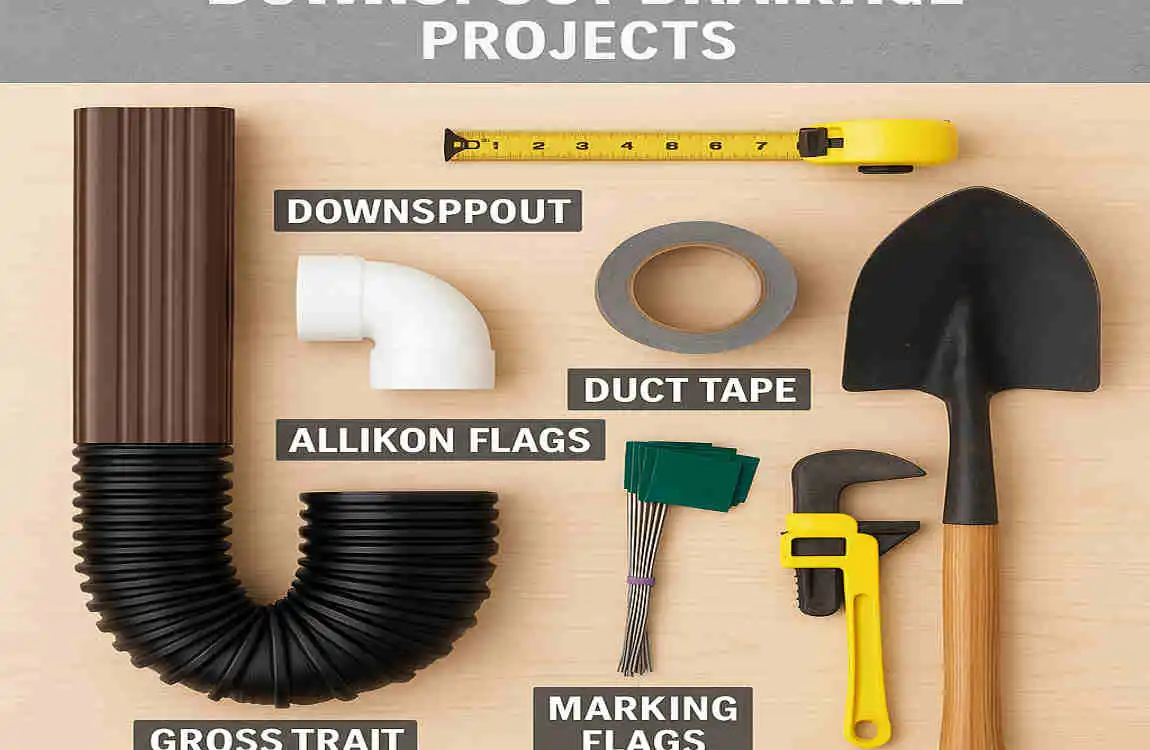
Essential Materials for Your Drainage Project
Before you start your drainage project, gather these key materials:
Material Purpose Estimated Cost
Downspout extensions: Direct water away from the foundation $10-30 each
PVC pipes (4-inch), Underground drainage $10-15 per 10 feet
Pipe connectors join sections together $3-5 each
Landscape fabric prevents soil infiltration $20-30 per roll
Gravel/drainage rock: Facilitate water flow $30-50 per cubic yard
Splash blocks: Disperse water at outlets $15-25 each
Tools You’ll Need
Having the right tools makes all the difference. Here’s what you’ll want on hand:
- Shovel and spade for digging trenches
- Level to ensure proper slope
- Tape measure for accurate distances
- Hacksaw or PVC cutter for pipe cutting
- Drill with bits for securing extensions
- Work gloves to protect your hands
- Safety glasses for eye protection
Choose quality materials that can withstand your local weather conditions. In freezing climates, opt for materials that won’t crack in cold temperatures. In areas with intense sunlight, UV-resistant materials help prevent degradation.
Maintenance Tips for Long-Term Efficient Drainage
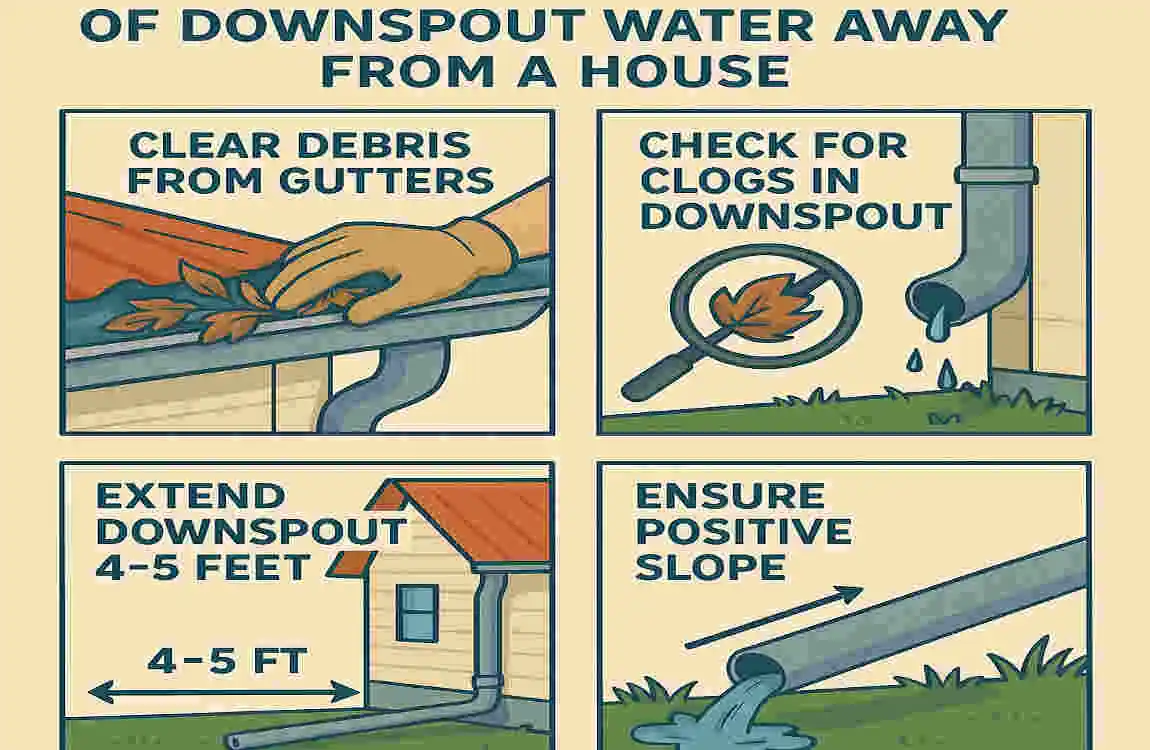
Regular Inspection Schedules
Mark your calendar for bi-annual inspections – once in spring and once in fall. During these checks, look for signs of standing water, soil erosion, or moisture in the foundation. Walk around your home after a rain to see where water flows and pools.
Check your gutters and downspouts for clogs at least four times a year. If you have many trees near your home, you might need monthly checks in the fall. Remember, a few minutes of prevention saves hours of repair work.
Seasonal Maintenance Strategies
Spring brings heavy rains in many areas. Clear winter debris from gutters and ensure all drainage paths are open. Check for frost damage to pipes and extensions.
Summer is perfect for significant repairs and installations. Dry weather makes digging easier and gives you time to complete projects before fall rains.
Fall means leaf management. Install gutter guards if you haven’t already. Clear leaves regularly to prevent clogs. Disconnect and store flexible extensions if you live in a freezing climate.
Winter requires special attention in cold regions. Ensure downspouts won’t freeze and create ice dams. Keep snow and ice clear from discharge areas.
Common Mistakes to Avoid
Don’t make these rookie errors:
First, never direct downspout water toward your neighbor’s property. It’s not just inconsiderate – it might be illegal.
Second, avoid creating a negative slope toward your foundation when adding soil or landscaping. Always maintain that crucial slope away from your home.
Third, don’t ignore minor plumbing problems. That tiny leak or slight pooling becomes a significant issue over time. Address problems when they’re small and manageable.

